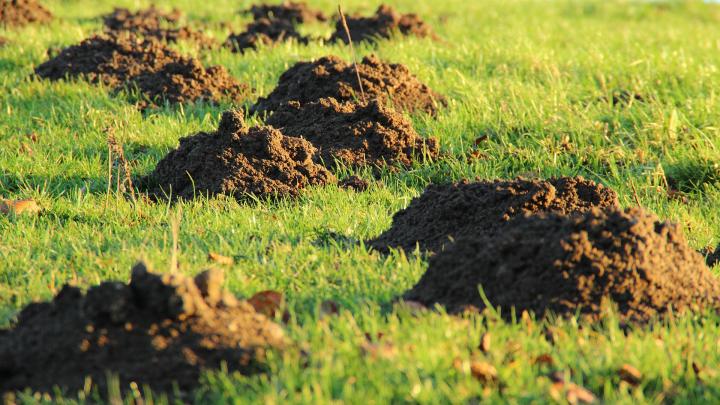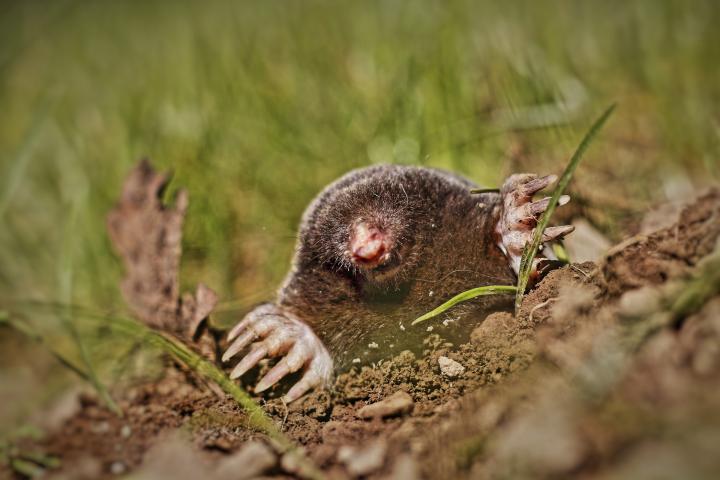
Moles can be a nuisance to the gardener because they dig up the soil. Here are tips for how to get rid of a mole.
How to Identify and Get Rid of Moles
ADVERTISEMENT
don't take your moles ( chipmunks raccoons etc..) to rural areas. WE DON'T WANT YOUR PROBLEMS.
Another solution to attempt is to go to Walmart/Academy Sports/Amazon online, and purchase (Red Fox Urine or Grey Wolf Urine), for approximately less than $20USD a bottle.
You take the urine bottle (Stand UP WIND!+ Wear GLOVES!), and either spray the Urine on ‘Scent Keys’ (Shaped like a “P” or a “T”) (OR) Spray the Urine on a material like a Cat Ball (cotton or fabric material that will hold the scent) (OR) Cotton Material Scraps/Rags, and
THEN take those sprayed items with the Urine Scent on them and Place one at each corner of Your Yard (at each corner of Your garden+Midway/the middle of each side of your garden - creating a box barrier), and midway/middle of each side of Your Yard - basically, You are creating an invisibility Box Scent Barrier. You can ALSO place some of the Scent Keys, Scent Balls, Scent Scraps down INSIDE the tunnel(s). The ‘smell’ of the Predator is what will drive the prey away.
The Theory behind this treatment is based on the Predator vs Prey Drive. That something bigger (Predator) that might EAT ME!, has moved into the area, so I (Smaller/Prey) should MOVE OUT! It usually works almost immediately, so it is best to apply this just before Dusk at night, so the prey naturally wakes up/becomes active and immediately looks to move out+Leave!
This works especially well, if You use the urine of an animal’s natural Predator. Moles, Voles, Field Mice, Etc are ALL PREY of Red Foxes!..Also, in the comments above, where someone states they used ‘Human Urine’, it likely had a similar effect, although not sure a Mole,Vole, Chipmunk, Mouse will recognize a Human as a natural predator+cause them to relocate.
Note: Must use when NOT raining, and reapply after rain (obviously the smell washes away)..
No Guarantee this will work for You, But, at like approx.$8usd a bottle for the Red Fox Urine it’s not much of an investment to lose if it doesn’t.
Plus, I have used this successfully to treat for house mice, (spread sprayed items under the house+sprayed each corner and midway of the house’s foundation/skirting), mice moved out in 24-48hrs. Continue to apply 1xweek, then 1x every 2wks, then 1x Mthly, unless they return, if they return, then step up treatment again to weekly.
I also had a small porch and something had crawled inside it, so just before dusk, I sprayed the heck out of that porch with the Urine. I went inside and waited to see what would happen. 10-15min (max) later, and whatever it was tore its way out from under the porch and took off & never returned..(I missed seeing it, because I got bored waiting, but I’m fairly sure it was a raccoon or a opossum).
Btw, do NOT use moth balls, read the label, they are horrid for the environment & can cause breathing issues for humans & bad for pets.
Yes!, this is No Kill, Yes, it moves the pests out of your property to the woods or someone else’s area, but that’s the nature of Humans living in Suburbia.
We are living in their environment.
Your neighbor may not garden, may not care, or may not even notice there are moles in their yard (or) the moles may move to the woods behind your houses or the open field where no one lives. You do not necessarily need to kill the Moles, Voles, Chipmunks, Mice, as they all serve their own purpose in nature, from pest control, etc..
Good Luck!!!
Last August our area was flooded which moved moles into my yard. Tried smoke flares, poison granules, glue boards, traps, repellent, human hair, planting garlic and green onions on edge of flower beds, buzzing stakes, and even called a pest control company ( they used the wrong bait, thought I said VOLES). The gummy worm did kill one mole last fall which my old cat found.( Told they would die underground). I've been trying to push it away from going deeper into my prized flower garden with 6" boards. So far it won't dig under them. The mounds can be huge, with 4"+ wide tunnels. Nearby a mound now something is eating my Veronicas. This sure is a smart monster! To hire a good pest control guy is over $350. The mound always appear in the morning, sometimes just a little hill, other times huge.
Had been digging post holes to repair a fence and found that several holes kept catching moles that would fall in and were unable to dig out. Not sure if its because the earth was packed and they couldn't break through or what, but worked fairly well.
brown big like a silver dollar screams like a mouse cant see legs black little eyes ,is it a baby mole or mouse ??? and very fast











Comments